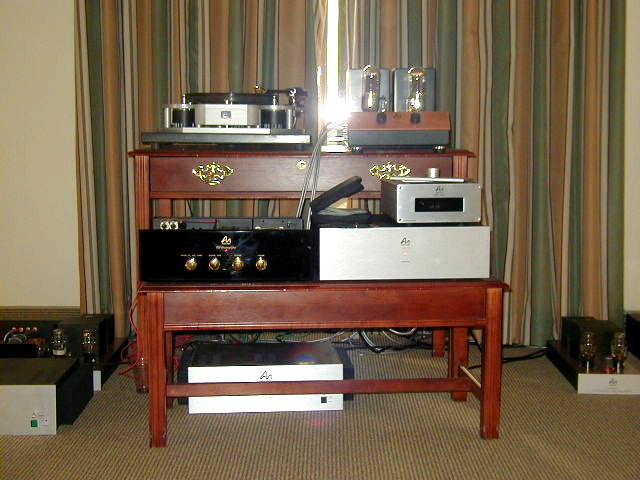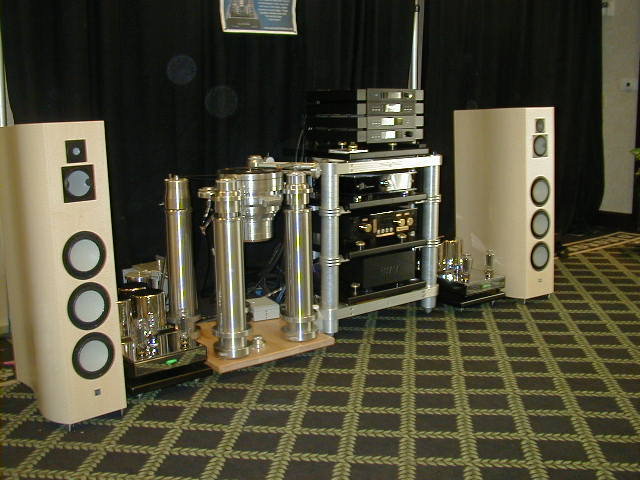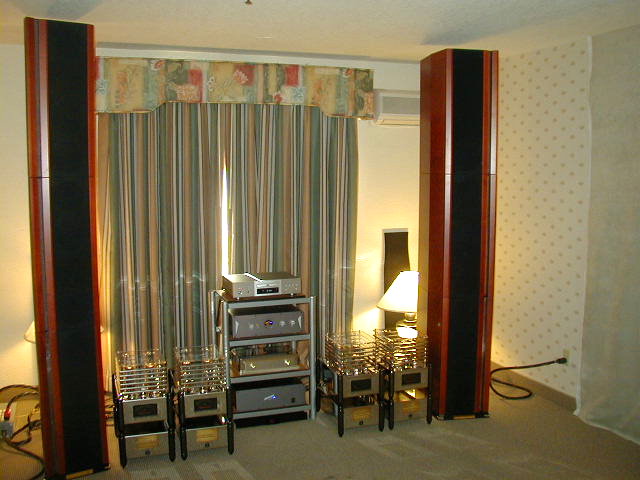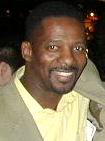CES 2004 Report Clement Perry
CES 2004 Another Great Show! Part One
Lost Wages, Nevada.
Clement Perry
I arrived in one piece. Considering what life is like these days post 9/11 air travel, the flight was relatively easy. Getting a taxi was not. I knew this was an omen. It took well over and hour. And it was only Wednesday! While the LVCC looked like a mad house, it seemed to me that overall, the attendance dropped a hair at both Alexis Park and the San Tropez. It just didn’t look as crowded as it did the past year. Passions, however, ran mighty high with the look and sound of a majority of the rooms. Minus some surprisingly crude setups and disappointing sound, this was another great year to be in attendance at CES. Albert Von Schweikertaccomplished a miracle in his room at the San Remo pitting virtual against live. ESP loudspeaker lovers would have fainted to hear the return of Sean McCaughan’s flagship Concert Grands at the San Tropez. And new European imports like the Ascendo room sounded improved over last year’s with first time German electronicsPhonosophie. It was a pleasant surprise to see Wadia’s new and exciting products taking up space in some of the rooms (notably their own and Nova’s).
There was plenty to see walking the show with Dave Thomas, Mike Wright and Key Kim. One of the more enlightening elements of having four reviewers listen together (one at a time), is to find if their tastes match your own. And knowing Key’s, since he’s a neighbor, personal friend and uses the same electronics as his reference, it was with a sigh of relief that I found the tastes of both Dave and Mike to mirror ours. They thought the sound of the Ascendo room as superior compared to many others. I found this illuminating since they serve as reference loudspeakers for both Key and myself. Never did I want to give any impression of what makes this loudspeaker special. And as good as the room did sound, I thought there was still a lot to accomplish with respect to the room–after all, it is my reference. The Ascendo loudspeaker can sound A LOT better than what we heard there in CES in a larger room. Give that loudspeaker room to breath and it can be pretty impressive sounding. There was no question that the Phonosophie line of electronics are no slouch despite their rather bland European style and appearance. They sounded better matched with the Ascendos than the world class Zanden products used last year. Go figure.
Interesting turn of events: Not surprising. While most of you turned away from room correction products they couldn’t have been more popular this year. With the increasing presence of parametric equalizers like Rives Audio PARC and Australian newby Deqx. Rooms using these products sounded very well balanced particularly in the bass regions. None of the rooms using the PARC or Deqx, and I counted nearly a dozen, produced boomy bass which is usually typical under show conditions when attempting to play loud. The only logical reason I can come up with why Tact Audio, my longtime reference pre/room correction device, isn’t being used in setups such as these is; Tact is simply too hard and intimidating and/or its sonic benefits seem to be overkill where a touch of correction may be only necessary. Of course I don’t agree that Tact is overkill but then again I’ve never auditioned either of these two competing products. Yes, I do agree that the Tact 2.2X can be intimidating upon first blush. One thing’s certain: The room is still the least understood and most overlooked. The more companies that offer room correction capabilities the better because it only allows us to see how overlooked this situation actually has become. Okay, on to other pet peeves.
Disappointing setups

Who was it that said a picture is worth a thousand words? Audio Note should be ashamed of themselves for this setup (above). Can you imagine how this room must have sounded looking at this photo? Just the thought they used hotel furniture makes me dizzy. Notice from the photo the Audio Note transport resting directly on the $35k DAC! Well, I heard it with my own two ears and it wasn’t nearly as good as I would have thought considering the price of these components and the reviews Constantine Soo did right here. Truth be told, it sounded better than it looked. Actually, there was a sense of string tone authenticity that was impressive but that isn’t the only thing that makes music sound right — and just as importantly — inviting. There’s body, there’s dynamics, there’s midrange three-dimensionality and there’s realism. Lastly, there’s size and scale. All of these audiophile MUSTS seemed lacking. These MUSTS are the very reason dedicated equipment like isolation platforms and racks are a must; the very things overlooked by this room. Considering show conditions, which are usually never ideal in the first place, there’s no getting away with using a standard el’ cheapo power strip, and hotel furniture. Tsk, tsk.

Unfortunately there was another poor setup in the Alon By Acarian room. The room was composed of great electronics like the Antique Sound Labs Hurricane (200 watt) tube monoblock amplifiers ($4,400 pair) as well as Conrad Johnson’s ART II preamp ($15,990). The digital was by way of the newly imported Lector Strumenti Audio CD Player ($3,200),while all cabling was by Soundstring Cable Technologies designed by local hero Jed Hacker. Alon’s designer Carl Marchisotto (above) is showing his Alon Proteus loudspeaker ($45,000) and setup against two adjoining walls similar to the way Balanced Audio Technology does each year. Except, the first thing I could tell upon sitting that there was no sweet spot the way the loudspeakers were set up to aim at the listener evenly. Somehow it was grossly uneven. I immediately asked Marchisotto “where’s the sweet spot?” He never once looked at me after posing for our camera, and dismissively stated, “just listen to the music. You don’t ask for the sweet spot when it’s live.” Oh my God, I’m about to have a brain cramp! How enlightening Mr. Marchisotto but this isn’t live. When it is [live], people are there in front of you so soundstage never becomes an issue. Needless to say, I looked to my left at Key Kim who, sitting next to me, looked as dumbfounded as I was. We both got up and walked right out without uttering a syllable. However, I do have good news Mr. Marchisotto; I saved $325 on my car insurance switching over to Geico.
On to Excellent Setups

The Acoustic Dreams room, using the same room as last year at the San Remo, with practically the very same electronics, offered a delightfully musical setup. Employing the elegant and long legged Vyger Indian Signature ‘table ($36,000) to get the show started made life a tad easier for the Featherling brothers (they caught hell trying to figure out what was wrong with a left channel connection. Alas, it was a defective interconnect! Loudspeakers were the Lumen White ($40,000 plus) while a pair of Ayon Signature monoblocks supplied current. All digital gear was dCS, while the superbly built equipment rack ($6,000 for a four tier unit) were made by Acoustic Dreams.
Outstanding Performance

No wonder these things are so hard to choose when making a purchase decision. The sound of the Joseph Audio Pearl loudspeakers ($20,000) was intoxicating. Strapped to a pair of Joule Electra Rite of Passage OTL monoblocks resting on custom amp stands made by Critical Mass Systems certainly lent a helping hand. Cables as well as AC cords were all by Elrod Power Systems, while AC conditioning was done via Sound Applications Line Stage ($4,000). Needless to say, this was a sonic sensation.

Jay Bertrand, Importer extraordinaire, put on some display with a pair of referenceDALI loudspeakers ($40,000) that nearly went to the ceiling that were being driven by two sets of Ming-Da vacuum tube monoblock amplifiers ($12,500) [using the 845 tube for power and the 300B for drivers].

Jay also introduced Zindak’s new tubed SACD player SCD2 ($1,850) which performed some feat used solely as a transport into the Zanden Model 5000 MkIII. New on the scene is the Messenger Reference tube preamplifier ($12,500) designed by Bruce Wulach this new upstart designer has seemed to hit the proverbial home run with this two-boxed delight. Comprised of single 6829 input tubes and single 6AS7’s at the output. For the ultra choosy, Wulack also offers optional solid-state or tube power supplies. Cabling and AC cords were supplied by Zindak. This was certainly one of the best sounds at the show. Keep an eye out on these new products.
Good Sounding Multi-Channel

AV123’s Mark Schifter introduced new products at this year’s CES event. TheEmotiva DMC-1 processor boasting Precision Motorola Symphony™ based 7.1 Channel Dolby Digital, Dolby Digital EX, Dolby Pro-Logic II/IIx, DTS, DTS-ES, and DTS Neo:6, decoding and the MPS-1 Modular 200-watt multichannel amplifier (prices to be determined) did a nice job showing all there is to be had from multi-channel audio as well as video. Keep an eye out on this product.
Elegant Sounding

Balanced Audio Technologies did another great job as usual integrating the room with their electronics. This year, using Avalon’s newest member in the Ascendant loudspeaker ($7,995). Also, BAT introduced the all new VK-600, featuring only two gain stages, and a Zero Gobal Feedback Design to go with its new faceplate design.Flexibility is BAT’s newest achievement for the VK-600 can be ordered either in stereo or monoblock configuration. Cabling, as well as AC room conditioning was by way of Shunyata Research. The elegant stand is by pARTicular.

Clement Perry
 Talon Audio was EVERYWHERE this year. A good sign. Mike Farnsworth and Team Talon has really made an impact with their new line of eye catching loudspeaker designs. The Firebird (above $40,000 with Diamond tweeter) is Talon’s new statement loudspeaker. Team Talon, from its beginning, when I first named them as my reference, has pursued the dream of progressing the technology of loudspeakers. The Firebird, which our own Greg Petan has in for review, sports sonic capabilities that clearly makes it superior to the Talon Khorus MkII.
Talon Audio was EVERYWHERE this year. A good sign. Mike Farnsworth and Team Talon has really made an impact with their new line of eye catching loudspeaker designs. The Firebird (above $40,000 with Diamond tweeter) is Talon’s new statement loudspeaker. Team Talon, from its beginning, when I first named them as my reference, has pursued the dream of progressing the technology of loudspeakers. The Firebird, which our own Greg Petan has in for review, sports sonic capabilities that clearly makes it superior to the Talon Khorus MkII.
The first of which is their new enclosure design. Talon was first known for using dual woofers in a modified transmission line enclosure. They now use a single woofer in a smaller and more advanced enclosure and yield much improved performance. The reason why the results are so much better Talon says “is because the THD (total harmonic distortion) is so much lower along with an improved impedance response. Lower THD will offer greater power handling and the improved impedance response will improve the speakers low frequency response.“ Talon has also introduced a new crossover circuit. Talon prefers this new circuit since it offer steeper slopes with less phase shift than 6 dB circuits. The steeper slopes are varied to match the woofer/midrange/tweeter implementation. These steep slopes are also advantageous for ceramic drivers. This circuit also offers “Common Mode Rejection” which lowers noise in the circuit. This is why Talon refers to their crossover as CMRC or Common Mode Rejection Circuit. Unique to the Firebird is the impedance drains mounted on both sides. Inserted with a dovetail joint are ½” thick panels that cover almost the entirety of the side panel. By mounting these plates to the side of the Firebird an impedance drain is created to pull standing waves away from the main body. Also included are mechanical dampening plates that are strategically located to reduce cabinet wall various wall vibrations.
Talon Audio Hawk (right $9,000) shown with matching stands (Machined Aluminum and sand filled @l $2,200) Talon Audio ThunderbirdSubwoofer was one serious looking product ($11,000) powered by a Crown K-2amplifier).Electrocompaniet’s AW400mono amps ($8000/pr), EC 4.7 Preamp ($3000), EMC 1-UP CD Player R ($5500) were used in conjunction with, and again, Rives PARC Room Correction ($2950), HRS 4 shelf isolation rack ($7950). All cabling was bySynergistic Research while AC Power Conditioning was handled by Bybee Research
matching stands (Machined Aluminum and sand filled @l $2,200) Talon Audio ThunderbirdSubwoofer was one serious looking product ($11,000) powered by a Crown K-2amplifier).Electrocompaniet’s AW400mono amps ($8000/pr), EC 4.7 Preamp ($3000), EMC 1-UP CD Player R ($5500) were used in conjunction with, and again, Rives PARC Room Correction ($2950), HRS 4 shelf isolation rack ($7950). All cabling was bySynergistic Research while AC Power Conditioning was handled by Bybee Research
 The Talon Audio Firebird Diamond’sretail price of $40000 may be too rich for your blood but equipped with Chapter Audio III+’s amplifier (rated at 300wpc and $11000) and Chapter Audio Preface preamplifier ($9000), the sound was very, very musical. The sound coming from these two large speakers seemed to disappear when the music started. Same usual suspects were used in the front-end: Electrocompaniet EMC 1-UP CD Player, Rives PARC Room Correction. HRS 4 shelf isolation rack retail excepting cables. Cabling used exclusively for this room was byElrod Power Cords. Power Conditioning was by Sound Application.
The Talon Audio Firebird Diamond’sretail price of $40000 may be too rich for your blood but equipped with Chapter Audio III+’s amplifier (rated at 300wpc and $11000) and Chapter Audio Preface preamplifier ($9000), the sound was very, very musical. The sound coming from these two large speakers seemed to disappear when the music started. Same usual suspects were used in the front-end: Electrocompaniet EMC 1-UP CD Player, Rives PARC Room Correction. HRS 4 shelf isolation rack retail excepting cables. Cabling used exclusively for this room was byElrod Power Cords. Power Conditioning was by Sound Application.
 Talon Audio had a huge display in the San Remo (right) that featured three Talon Audio Cinemas ($6,500), a pair of Talon Audio Thunderbirds ($11,000). Electronics featuredGryphon’s fabulousAntileon Stereo($24,000), three Gryphon Encore stereoamplifiers ($14,000), Gryphon’s Sonata Allegro preamp ($14,000). The GryphonMikado CD Player ($12,000) was also in-house and sounded as beautiful as I remember it in my listening room (stay tuned for review). The ubiquitous Rives PARC Room Correction ($2950) was also used in yet another outstanding setup. Synergistic Research Resolution Reference with v. 2 Active shielding cabling was used throughout. Power Conditioning was all Balanced Power Technologies, featuring their BPT 3.5 Signature Line Conditioner. Equipment rack used was HRS 4 shelf isolation rack ($7950)
Talon Audio had a huge display in the San Remo (right) that featured three Talon Audio Cinemas ($6,500), a pair of Talon Audio Thunderbirds ($11,000). Electronics featuredGryphon’s fabulousAntileon Stereo($24,000), three Gryphon Encore stereoamplifiers ($14,000), Gryphon’s Sonata Allegro preamp ($14,000). The GryphonMikado CD Player ($12,000) was also in-house and sounded as beautiful as I remember it in my listening room (stay tuned for review). The ubiquitous Rives PARC Room Correction ($2950) was also used in yet another outstanding setup. Synergistic Research Resolution Reference with v. 2 Active shielding cabling was used throughout. Power Conditioning was all Balanced Power Technologies, featuring their BPT 3.5 Signature Line Conditioner. Equipment rack used was HRS 4 shelf isolation rack ($7950)

English speaker designer Derek Wilsonhas taken the Manger driver and Talon Audio’s Firebird woofer technology and combined them to make a loudspeaker named theOvation ($40,000). He and originally met in at the Frankfurt Show last spring, and he seemed like a fellow who was possessed with making his own version of a world class loudspeaker. He showed me many photos of this design and, personally, I thought it was some achievement to build your own loudspeaker using world famous drivers and Talon Audio’s technology being the big fan I am of their subs. I simply wondered aloud how it could potentially sound. Well, I finally got that chance to hear them for myself. Using familiar electronics in the Electrocompaniet amplifiers, pre and EMC CD player, I must say that Overkill Audio has something worthy in their first offering. The sound was fast as lightening, and at the same time, had some of the deepest and tightest bass I heard at the show. Overall, I would say the sound was a bit too forward for my liking but it did impress everyone in the room on most of the material I pulled out of my CD collection. I requested a review sample and will report my findings.

One of most exciting products witnessed at this year’s CES event was the return of the ESP Concert Grands. Shown above in the tmh Audio room strapped to WAVAC amplifiers was quite inviting sonically but not nearly as inviting as it was in the Critical Mass Audio setup. Can’t explain it either but there was a big difference between the two rooms using the same loudspeakers with Japanese tube electronics. The sound in the tmh room was nice, real nice, yet I got the immediate impression the speakers begged for some needed breathing room. Perhaps burn-in had something to do with their sound as well.

But listening to this setup (right) had me literally pulling out all my CD’s and locking the door for what seemed like hours of uninterrupted listening sessions. This also should explain why this photo is dark. My apologies but the room lights were turned low and we all forgot to get them back on when the session was over. The sound of this room easily earned “Best Sound” for its sheer musicality especially when one considers the price of all electronics which were:Alex Peychev-modified Philips SACD 1000 player (modification price $1,850 Alex’s website is www.aplhifi.com). You may not know it unless you were in the room, but we were playing Redbook almost exclusively, and the sound was such that we never felt the urge to play SACD’s. The player has a tube output stage. I understand from Alex that our own Todd Mitchell has a review sample. So stay tuned for an exclusive!
A Concert Fidelity preamp, the CF-040 ($6,000) was used during the intense listening session. Designer Masataka Tsuda (from Japan) uses an extremely simple and refined circuit, and he claims that the sound of the best tube equipment should be the sound of the tubes themselves (i.e., the better–purer and simpler–the circuit, the more difference a tube swap will make, which makes intuitive sense). [Starting out with an Electro-Harmonix 12AU7, and switching to a set of NOS Mullards, made everybody’s jaw drop at the difference.]
session. Designer Masataka Tsuda (from Japan) uses an extremely simple and refined circuit, and he claims that the sound of the best tube equipment should be the sound of the tubes themselves (i.e., the better–purer and simpler–the circuit, the more difference a tube swap will make, which makes intuitive sense). [Starting out with an Electro-Harmonix 12AU7, and switching to a set of NOS Mullards, made everybody’s jaw drop at the difference.]
Power amps were also Concert Fidelity’s 6B4G parallel push-pull monoblocks ($14,000 per pair with extremely low margins–these amps are too expensive to produce, and if Mr. Tsuda had name recognition, they would have to sell for $20,000 or more I’m told). The same thing happened with this amp when Mike Veretto, owner of Critical Mass got some NOS Sylvania tubes for the gain/driver stage in place of the Electro-Harmonix 6SN7’s. This swap was done Friday night I’m told, and I believe I arrived the next day. I’m told the differences were not subtle. The amps use a special circuit configuration in order to get 60 watts out of what is essentially the same tube as a 2A3. I don’t know how Mr. Tsuda does this, and he probably wouldn’t want to divulge his secrets anyway, but the sound is much more powerful than any 2A3-based amp, while retaining a very high purity quotient.
Cabling and power conditioning were all by Concert Fidelity, except for one interconnect lent by Alex Peychev. “I would hope that Mr. Tsuda attempts to market these, but he has not figured out how to wind the cables efficiently yet. They should be sellable within six months” says Veretto – who intends to price them very reasonably, not because they aren’t among the best he’s heard (Veretto uses them–“those were my personal cables” he claims). “Besides, he correctly asserts, I think it’s unethical to charge too much for cables.”
Speakers were, of course, the ESP Concert Grands, back after a six-year absence (price: $25,000). They have all new drivers, crossovers, wiring, and a new isobaric woofer configuration. The box is still essentially the same, and is built like the proverbial brick you-know-what! Sean has been designing for over twenty years, starting out on the Beveridge electrostatics, and is a perfectionist with an extremely deep knowledge of speaker design, but he is first and foremost a music lover who goes to live concerts two or three times a week and enjoys talking about music more than audio. Speaking with him makes me appreciate just how speaker design is as much art as science.
Stay tuned for more CES coverage!
![]()
Stereo Times Masthead
Publisher/Founder
Clement Perry
Editor
Dave Thomas
Senior Editors
Frank Alles, Mike Girardi, Russell Lichter, Terry London, Moreno Mitchell, Paul Szabady, Bill Wells, Mike Wright, and Stephen Yan,
Current Contributors
David Abramson, Tim Barrall, Dave Allison, Ron Cook, Lewis Dardick, John Hoffman, Dan Secula, Don Shaulis, Greg Simmons, Eric Teh, Greg Voth, Richard Willie, Ed Van Winkle, Rob Dockery, Richard Doran, and Daveed Turek
Site Management Clement Perry
Ad Designer: Martin Perry





Be the first to comment on: CES 2004 Report Clement Perry